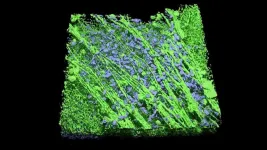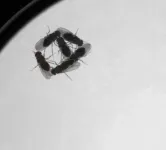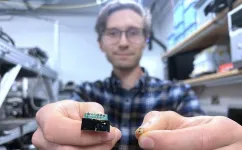(Press-News.org)
A team of researchers at USC and the University of Utah has received a $2.7 million grant from the National Institutes of Health to map out how an incurable eye disease affects the wiring that powers vision in the eye, in hopes of discovering ways to slow or prevent blindness. Retinitis pigmentosa (RP) is a progressive disease with four known stages that affects the retina, the area at the back of the eye where light is turned into electrical signals that the brain processes to produce sight. The research team seeks to develop comprehensive maps for each stage, detailing nerve connections in the retina and how they break down.
RP, an inherited condition affecting about 2 million people globally, causes cells in the retina to die off. Usually arising during childhood, RP leads to gradual loss of peripheral vision, narrowing the field of sight to nothing over time.
“We’re optimistic that this is the right time for this project,” said principal investigator Gianluca Lazzi, PhD, a USC Provost Professor of Ophthalmology at the Keck School of Medicine of USC and of Electrical and Computer Engineering, Clinical Entrepreneurship, and Biomedical Engineering at the USC Viterbi School of Engineering. “We know how to handle data in a way that was unimaginable even five years ago. We believe this will keep growing while we’re doing the work, enabling us to handle even more.”
The map of the retina’s nerve network, referred to as a “connectome,” functions similarly to a wiring diagram, showing how nerve cells, or neurons, transmit signals. By linking changes in structure to changes in function, the team hopes to gain valuable insights for battling RP.
“There’s an old saying, ‘Don’t tell me what it is; tell me what it does,’” said Lazzi, who is also the Fred H. Cole Professor of Engineering at USC Viterbi. “We want to bring the entire network to life with functional models — showing what the disease does — that can be used by everybody working in this field. Collectively, we’ll have a better shot at developing effective therapies.”
The death of retinal cells in RP kicks off a secondary problem that is of particular interest to Lazzi and his colleagues. Casualties leave healthy neurons disconnected. They, in turn, link up with the wrong cells and block correct connections, escalating damage.
“One neuron dies, and the other realizes no one is receiving the signal, but talking to somebody else turns out to be a bad idea,” said Lazzi, director of the USC Institute for Technology and Medical Systems. “If we can unlock what drives this change, we can imagine a future where we can drive the neuron to make a better connection, one that slows progression of the disease.”
The team, which unites USC Viterbi, the Keck School of Medicine of USC, the USC Dornsife College of Letters, Arts and Sciences, and the University of Utah School of Medicine, uses two complementary imaging techniques for the connectome: two-photon excitation microscopy and transmission electron microscopy.
Two-photon excitation microscopy, which can look deep into tissue without causing damage, allows the researcher to visualize the entire retinal system while tagging individual populations of neurons with different fluorescent colors. This work is led by Michael Bienkowski, PhD, a USC assistant professor of physiology and neuroscience, the director of the USC Center for Integrative Connectomics and a member of the USC Laboratory of Neuro Imaging at the USC Mark and Mary Stevens Neuroimaging and Informatics Institute. He has developed a way to selectively deliver fluorescent dye to neurons using a neutered form of the rabies virus.
“Mike’s technique allows us to image a precise layer of the retina,” Lazzi said. “We can capture the entire image of, say, all the ganglion cells, so there’s no confusion between different types of neurons. This is a huge advantage.”
The other imaging technique, transmission electron microscopy, records details smaller than the wavelength of light, enabling the scientists to zoom in to examine the individual synapses where neurons connect. Retinal neuroscientist Bryan Jones, PhD, of the University of Utah oversees the electron imaging and the specialized laboratory models needed for the research.
Lazzi focuses on computation and modeling with the assistance of Jean-Marie Bouteiller, a USC research associate professor of biomedical engineering. That venture that will incorporate artificial intelligence to recognize attributes of healthy neurons. Electrophysiologist Steven Walston, PhD, assistant professor of research ophthalmology at the Keck School of Medicine, will play a crucial role in validating the team’s investigations by profiling electrical signaling in the retina.
“Steve’s contributions enable us to correlate the results of the computational models with experimental measurements,” said Lazzi. “Right now we don’t have a very clear answer to how a given cell in stage four of degeneration responds to stimuli. We’re looking for those answers.”
The grant builds on previous studies funded by the NIH and the National Science Foundation, including electron microscopy–based connection models of the retina in health and in the earliest stage of RP. Lazzi describes the efforts of the combined team as convergent research, a mission-driven collaboration engaging experts from different spheres in all phases of the project.
“This is true cross-fertilization,” he said. “We’re working together on an entire mesh of activities. In that environment, you learn and adapt. You operate in areas that might push the borders of the box you’re used to. But that’s entirely the point — there shouldn’t be a box, right?”
END
AI will soon receive a dose of empathy with the goal of helping to match people with depression to their best-fit medication. A team led by Farrokh Alemi, a professor in the College of Public Health (CPH), and Kevin Lybarger, an assistant professor in the College of Engineering and Computing (CEC), received $1,049,998 in research funding from the Patient-Centered Outcomes Research Institute (PCORI) to continue their work on developing an AI system that helps patients find the right depression medications.
With this funding support, Co-PIs Alemi and Lybarger will hone large language models (LLMs) to address known challenges in ...
CHAMPAIGN, Ill. — The Midwest played a central role in the growth of Black freedom movements in the 20th century. It was a key site for incubating and expanding the ideas of political activist Marcus Garvey, not only in the U.S., but globally, said University of Illinois Urbana-Champaign professor of African American studies and history Erik S. McDuffie.
McDuffie examined the influence of Garvey and the importance of the Midwest in the growth of Black internationalism and radicalism in his new book, “The Second Battle for Africa: Garveyism, the U.S. Heartland and Global Black Freedom.”
McDuffie ...
In most research labs, the scientists are on the same page about why they’re pursuing a research project.
But the Rubin Lab at HHMI's Janelia Research Campus isn’t an ordinary research lab.
The lab is examining how aggression affects vision in female fruit flies, but Janelia Senior Group Leader Gerry Rubin doesn’t care too much about the specific answer. Instead, he simply wants to see if the neuroscience research tools that he spent the last decade building are adequate to uncover the underlying mechanisms at play.
Postdoc Katie Schretter, on the other hand, is interested in understanding how neurons in the fly brain ...
HOUSTON, Dec. 12 2024 – A group of ambitious students from the University of Houston and Texas A&M University, identifying as the “Dream Team,” secured third place in the prestigious global Switch Competition. This annual virtual event, sponsored by the Switch Energy Alliance, challenges university students to develop innovative solutions for addressing energy poverty worldwide — a critical issue affecting millions.
The team is comprised of Sarah Grace Kimberly and Pranjal Sheth, both senior finance majors at UH, and Nathan Hazlett, a finance graduate student at A&M who previously earned a bachelor’s degree in petroleum engineering. Competing ...
For experiments that require ultra-precise measurements and control over atoms — think two-photon atomic clocks, cold-atom interferometer sensors and quantum gates — lasers are the technology of choice, the more spectrally pure (emitting a single color/frequency), the better. Conventional lab-scale laser technology currently achieves this ultra low-noise, stable light via bulky, costly tabletop systems designed to generate, harness and emit photons within a narrow spectral range.
But what if these atomic applications ...
A new analysis published in the journal Science reveals that overfishing has caused populations of chondrichthyan fishes – sharks, rays, and chimaeras – to decline by more than 50 per cent since 1970. To determine the consequences, a team of researchers developed an aquatic Red List Index (RLI) which shows that the risk of extinction for chondrichthyan has increased by 19 per cent. The study also highlights that the overfishing of the largest species in nearshore and pelagic habitats could eliminate up to 22 per cent of ...
Clinicians who completed an American College of Lifestyle Medicine (ACLM) course introducing the foundations of lifestyle medicine and food as medicine reported significant improvements in their knowledge and confidence, as well as increases in how often they practice lifestyle medicine with patients, a research study found.
The findings are important because, while lifestyle behavior changes are often the optimal treatment option in clinical practice guidelines for noncommunicable chronic diseases, many clinicians cite their lack of knowledge and training in lifestyle behavior interventions as a barrier. A growing body of evidence supports the ...
An international team of scientists headed by Dr. Lukas Bruder, junior research group leader at the Institute of Physics, University of Freiburg, has succeeded in producing and directly controlling hybrid electron-photon quantum states in helium atoms. To this end, they generated specially prepared, highly intense extreme ultraviolet light pulses using the FERMI free electron laser in Trieste, Italy. The researchers achieved control of the hybrid quantum states using a new laser pulse-shaping technique. Their results have ...
It’s a question that has puzzled thinkers for centuries: Are we humans alone in our pursuit of fairness and the frustration we feel when others get what we want?
In recent years, evolutionary psychologists have suggested that we’re not all that special. Animals, from corvids to capuchin monkeys, express what humans might recognize as jealousy when, for example, they are passed over for a sought-after snack. Many argue this is evidence we are not alone in our aversion toward unfairness.
But new research from the University of California, Berkeley, makes the case that humans might be unique after all.
Using data from ...
Researchers at University of California San Diego and collaborating institutions have shed light on the ways that social risks, such as housing or food insecurity, pose barriers to routine cancer screenings. The study, published in JNCI Cancer Spectrum, found that patients experiencing social risks were less likely to receive orders for cancer screenings and even less likely to complete screenings when ordered. The study also found that patients experiencing social risks had higher rates of primary care ...





